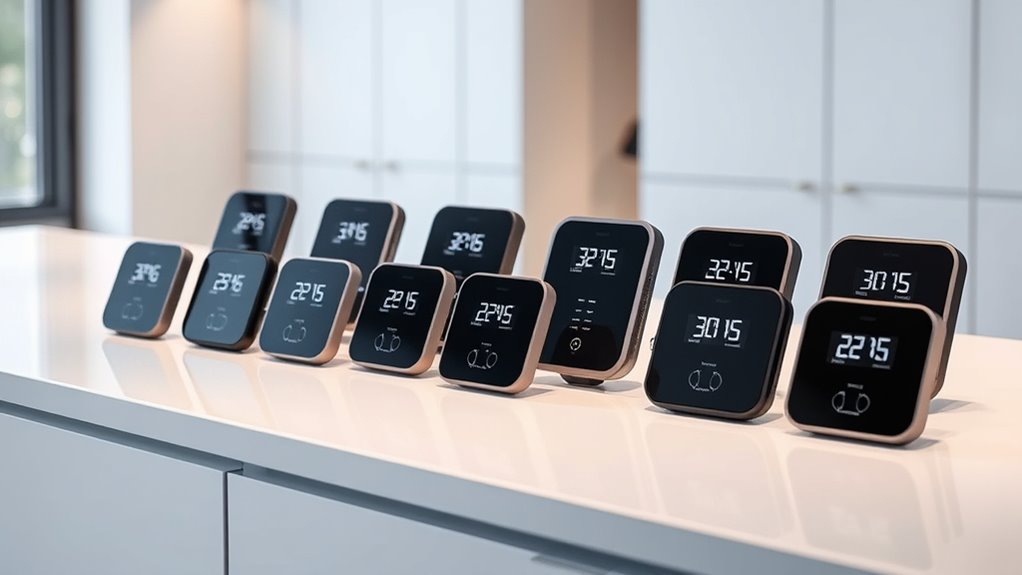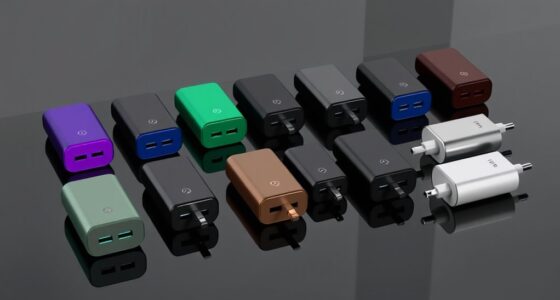If you’re looking to breathe cleaner air in 2025, I recommend exploring the top indoor air-quality sensors like multi-parameter monitors, smart devices with app connectivity, and simple plug-and-play options that measure CO₂, VOCs, formaldehyde, and more. These sensors are portable, easy to use, and alert you to potential issues instantly. To find the best fit for your needs and environment, keep exploring what features suit your lifestyle and safety priorities.
Key Takeaways
- Choose multi-parameter monitors with calibration, real-time alerts, and comprehensive readings for accurate indoor air quality assessment.
- Prioritize devices with smart home integration and user-friendly interfaces for seamless monitoring and control.
- Opt for portable, rechargeable models suitable for various environments like homes, offices, and travel.
- Ensure sensors use reliable technologies like NDIR for CO₂ and electrochemical for gases to maintain accuracy.
- Consider safety features such as alarms, visual indicators, and ease of setup to promote healthier indoor environments.
Mold Test Kit for Home with Mold Identification Guide

If you’re looking for a straightforward way to detect mold in your home, the Mold Test Kit with Mold Identification Guide is an excellent choice. It includes everything I needed for thorough testing—six petri dishes, cotton swabs, gloves, and a detailed guide. I used it to test multiple areas like my basement, bathroom, and air vents. The kit quickly revealed mold types and levels, helping me identify problem spots. It’s easy to use, safe, and cost-effective, providing fast results without sending samples to a lab. This kit made DIY mold detection simple, giving me peace of mind and a healthier living environment.
Best For: homeowners and DIY enthusiasts seeking an easy, safe, and cost-effective way to detect and identify mold in various areas of their home without professional help.
Pros:
- Complete testing kit with all necessary supplies included for easy at-home use
- Fast, lab-free results that help identify mold types and levels promptly
- Suitable for testing multiple areas and surfaces, providing comprehensive indoor air quality insights
Cons:
- May require careful interpretation of results for accurate assessment
- Not a substitute for professional mold inspection in severe cases
- Limited to surface and air testing; cannot replace detailed lab analysis for complex mold issues
Air Quality Monitor with CO2, HCHO, TVOC, Temperature & Humidity
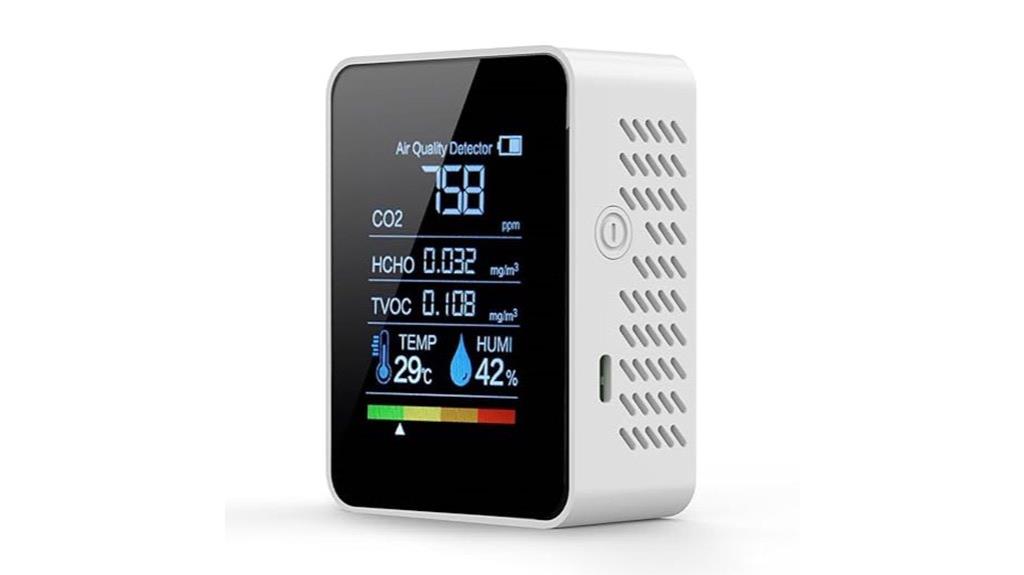
The Air Quality Monitor with CO2, HCHO, TVOC, Temperature, and Humidity is an ideal choice for anyone seeking an all-encompassing and easy way to track indoor air safety. This compact device measures five key indicators, helping you identify potential health risks caused by pollutants and poor air quality. It’s simple to set up, portable, and offers up to 20 hours of continuous use without plugging in. Perfect for homes, offices, or even cars, it provides real-time data, empowering you to proactively manage your indoor environment and breathe cleaner, healthier air every day.
Best For: individuals and families seeking a portable, comprehensive indoor air quality monitoring solution to ensure a healthy living or working environment.
Pros:
- Tracks multiple air quality indicators (CO2, HCHO, TVOC, temperature, humidity) for thorough monitoring.
- Compact and lightweight design allows easy portability and use in various locations.
- Up to 20 hours of continuous operation without needing to be plugged in, offering convenience and flexibility.
Cons:
- May require regular calibration to maintain sensor accuracy over time.
- Lacks advanced features like smartphone connectivity or data logging for long-term analysis.
- The small size might limit the display or ease of reading detailed data for some users.
Amazon Smart Air Quality Monitor – Know your air, Works with Alexa
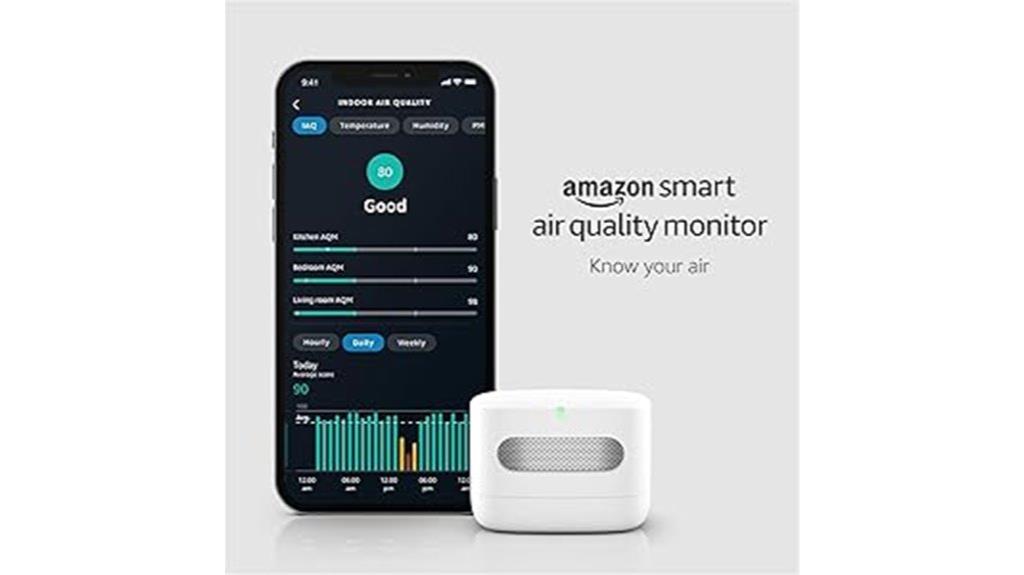
The Amazon Smart Air Quality Monitor is an excellent choice for homeowners who want real-time insights into their indoor air conditions and seamless integration with their existing smart home setup. It tracks five key factors—PM 2.5, VOCs, CO, humidity, and temperature—displaying clear air quality scores through a color-coded LED and the Alexa app. It also sends notifications or announces alerts if air quality drops. Compatible with Alexa, it can trigger routines that activate purifiers or fans automatically. Its built-in temperature sensor helps maintain comfort, and setup is straightforward thanks to its “Certified for Humans” certification. This device makes monitoring indoor air effortless and integrated.
Best For: homeowners seeking real-time indoor air quality monitoring and seamless smart home integration to improve environmental comfort.
Pros:
- Tracks five key air quality factors (PM 2.5, VOCs, CO, humidity, temperature) for comprehensive insights
- Integrates easily with Alexa and supports routines for automatic control of air purifiers and fans
- User-friendly setup with “Certified for Humans” certification for simple installation and use
Cons:
- Requires compatible Alexa-enabled devices for full automation features
- May need additional sensors or devices for complete home air management solutions
- Limited to indoor air quality monitoring without advanced filtering or purification capabilities
GoveeLife Smart Air Quality Monitor with Sensors and LED Display
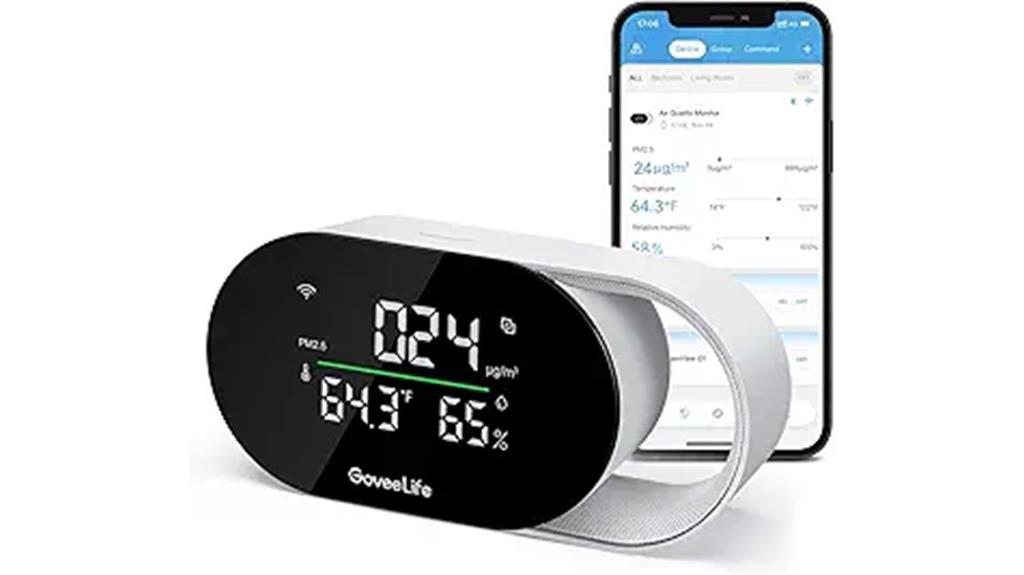
For anyone seeking a reliable indoor air quality monitor that integrates seamlessly with smart home devices, the GoveeLife Smart Air Quality Monitor stands out. It measures PM2.5, temperature, and humidity with good accuracy and displays data clearly on its LED screen, which shows the time, air quality levels, and can be dimmed or turned off. The device refreshes data every 2 seconds and connects via Wi-Fi, supporting Govee’s ecosystem for automation. It’s easy to set up through the app and can trigger connected devices like purifiers or humidifiers. While it doesn’t measure VOCs or CO2, it’s a solid choice for monitoring indoor air and automating home comfort.
Best For: individuals seeking a reliable, easy-to-use indoor air quality monitor that integrates seamlessly with smart home devices for automated air management.
Pros:
- Accurate measurement of PM2.5, temperature, and humidity with clear LED display
- Supports smart home automation by connecting with Govee devices and Alexa
- Easy setup via app with automatic data refresh every 2 seconds
Cons:
- Does not measure VOCs, CO2, or other air quality metrics outside PM2.5, limiting scope
- Some users report discrepancies in PM2.5 readings during wildfire events
- Requires continuous power as it lacks a built-in battery and relies on Type-C power supply
12-in-1 Portable Indoor Air Quality Monitor
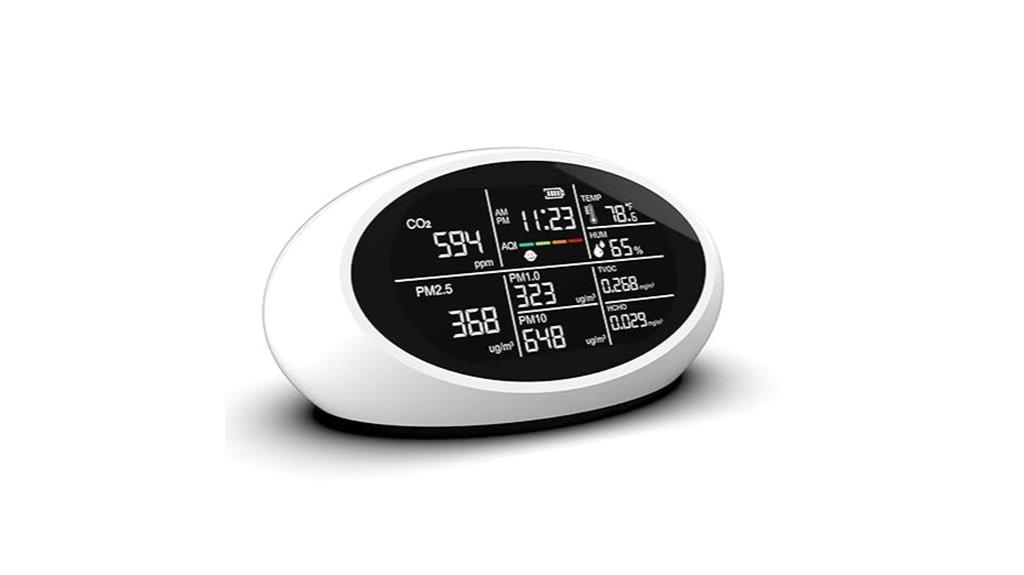
If you’re looking for a portable device that provides all-encompassing air quality data, the 12-in-1 Indoor Air Quality Monitor is an excellent choice. It offers detailed readings for CO2, TVOC, HCHO, PM1.0, PM2.5, PM10, humidity, temperature, AQI, and time, giving a thorough snapshot of indoor air health. Its upgraded dual-chip technology ensures fast, reliable results, while safety alerts like CO2 alarms and intuitive visual indicators keep you informed instantly. With a 5000 mAh rechargeable battery, it’s easy to use anywhere—home, office, or on the go. Its sleek design and user-friendly interface make continuous monitoring simple and effective.
Best For: individuals seeking comprehensive, real-time indoor air quality monitoring to enhance health and comfort in various environments.
Pros:
- Provides detailed multi-parameter environmental data including CO2, TVOC, HCHO, particulate matter, humidity, and temperature for thorough air quality assessment
- Equipped with safety features like CO2 alarms and intuitive visual indicators for quick, easy understanding of air conditions
- Portable with a long-lasting rechargeable battery, suitable for use in diverse settings such as home, office, or on-the-go monitoring
Cons:
- Constant buzzing sound that may be distracting when placed on desks or counters
- Requires manual calibration for optimal sensor accuracy, which may be inconvenient for some users
- Although user-friendly, some may find initial setup or interpretation of detailed readings slightly complex
AirKnight Indoor Air Quality Monitor and Sensor

Anyone seeking a straightforward, plug-and-play indoor air quality monitor will find the AirKnight Premium Indoor Air Quality Monitor an excellent choice. It’s a compact, 10-in-1 device that detects CO2, PM2.5, PM10, TVOC, formaldehyde, temperature, humidity, and gas levels, all displayed on a clear LCD screen. No apps, Wi-Fi, or Bluetooth are needed, making setup simple. Its rechargeable battery offers portability, perfect for homes, offices, or workshops. The device includes a CO2 alarm that triggers above 1000 ppm, providing critical safety alerts. While some calibration and battery life issues exist, its ease of use and all-encompassing monitoring make it a solid option for better indoor air quality.
Best For: individuals seeking a simple, portable, and reliable indoor air quality monitor without the need for wireless connectivity or app integration.
Pros:
- Easy to set up and operate with no need for apps, Wi-Fi, or Bluetooth
- Comprehensive real-time detection of key pollutants including CO2, PM2.5, TVOC, and formaldehyde
- Portable design with a rechargeable battery suitable for various locations and environments
Cons:
- Calibration issues with the CO2 sensor can lead to inaccurate readings
- Battery life may be inconsistent, especially with frequent alarms or in cold weather
- Lacks smart features such as remote monitoring, Wi-Fi, or app integration
Temtop Air Quality Monitor with Thermo-Hygrometer

Looking for a compact, easy-to-use air quality monitor that provides real-time data? The Temtop Air Quality Monitor with Thermo-Hygrometer fits that bill perfectly. It tracks temperature, humidity, PM2.5, and AQI, giving you a clear picture of your indoor environment. Its magnetic mount makes placement simple, whether at home, in the office, or at school. With energy-efficient technology, it offers up to 60 days of standby time, and keeping it plugged in guarantees accurate readings. This device helps me stay aware of potential health risks, especially from harmful PM2.5 particles, so I can take action to maintain a healthier indoor space.
Best For: individuals seeking a compact, energy-efficient air quality monitor for real-time indoor environmental tracking at home, office, or school.
Pros:
- Provides comprehensive air quality data including temperature, humidity, PM2.5, and AQI for a complete environmental overview.
- Energy-efficient design with up to 60 days of standby battery life, reducing charging frequency.
- Easy to install and operate with magnetic mounting and real-time monitoring, ensuring convenience and accuracy.
Cons:
- Keeping the device plugged in is recommended for the most accurate real-time readings, which may limit portability.
- May require periodic maintenance or calibration to ensure sustained accuracy over time.
- Slightly higher initial cost compared to basic air quality monitors lacking advanced sensors.
Eve Room Indoor Air Quality Sensor with Apple HomeKit
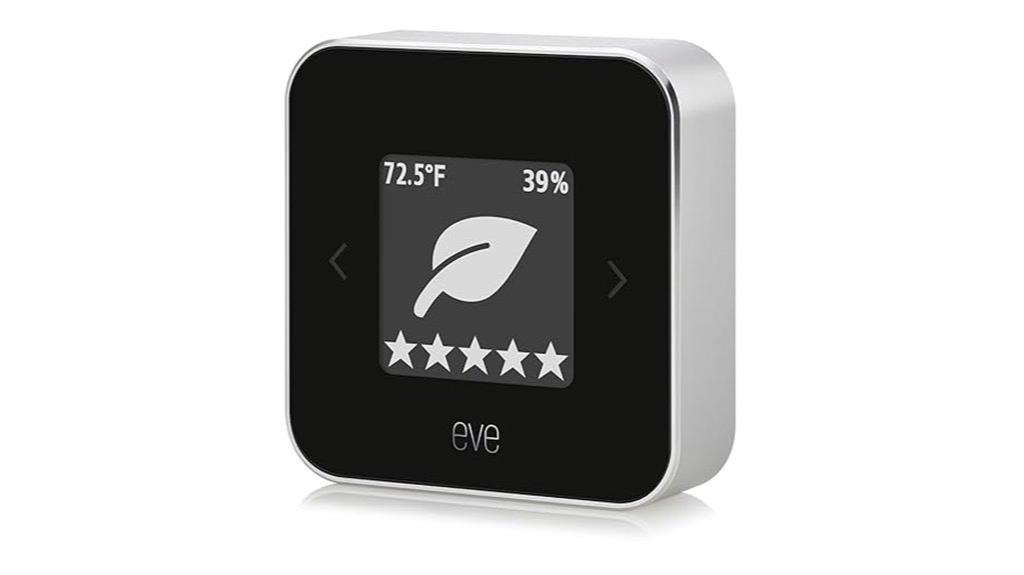
The Eve Room Indoor Air Quality Sensor with Apple HomeKit is an ideal choice for those who want precise, real-time monitoring of VOCs, temperature, and humidity in their smart homes. Its high-contrast e-ink display shows air quality at a glance, with color-coded indicators for quick understanding. Supporting Apple HomeKit, Thread, and Bluetooth, it integrates seamlessly into your existing ecosystem. The rechargeable battery lasts about six weeks, providing wireless placement flexibility. With advanced sensors and local data processing, Eve Room offers reliable, accurate insights to help you maintain healthy indoor air without relying on cloud storage, all wrapped in a sleek, minimalistic design.
Best For: those seeking a sleek, accurate indoor air quality monitor with seamless Apple HomeKit integration and real-time data insights.
Pros:
- Supports Apple HomeKit, Thread, and Bluetooth for easy setup and integration
- Features a high-contrast e-ink display with color-coded air quality indicators
- Offers a rechargeable battery with approximately six weeks of use per charge
Cons:
- App navigation can be complex, requiring multiple screens to access detailed data
- Limited compatibility outside the Apple ecosystem, with no native Google Home support
- Calibration period may take several days to stabilize for accurate readings
9-in-1 Indoor Air Quality Monitor with Large Display
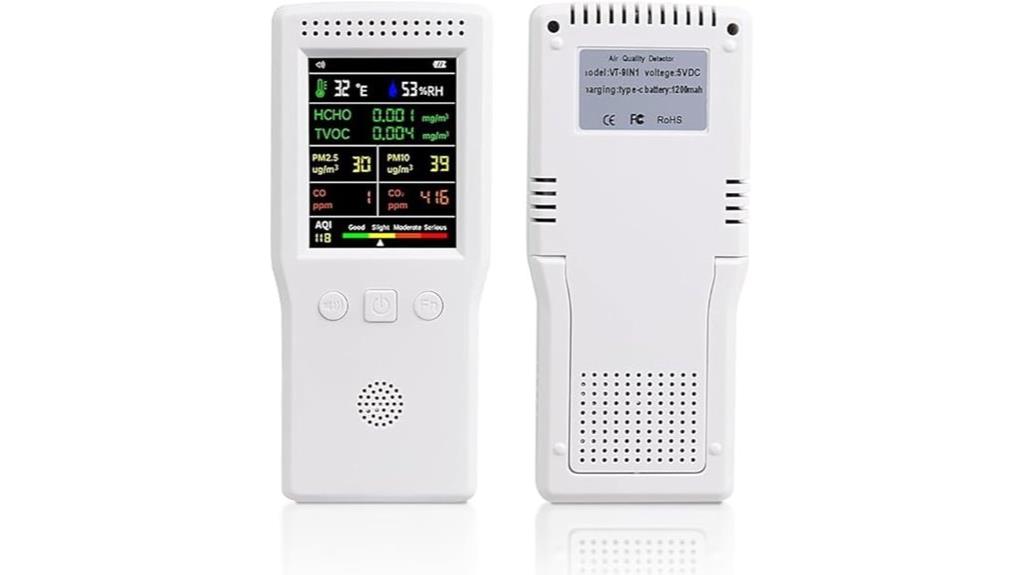
The in-1 Indoor Air Quality Monitor with Large Display is an ideal choice for those who want quick, accurate insights into their indoor environment without relying on Wi-Fi or smartphone apps. It uses multi-parameter detection with electrochemistry, semiconductor, temperature, and humidity sensors to measure pollutants like PM2.5, PM10, CO2, CO, HCHO, and TVOC in real-time. The large display shows digital readouts and color-coded bars, making it easy to understand air quality at a glance. With voice alerts and a rechargeable battery lasting up to 24 hours, it’s portable, simple to operate, and perfect for maintaining a healthier indoor environment anywhere in your home or office.
Best For: individuals seeking a reliable, easy-to-use indoor air quality monitor that provides real-time data without the need for Wi-Fi or smartphone apps.
Pros:
- Accurate multi-parameter detection using advanced sensor technologies.
- Large display with intuitive digital readouts and color-coded bars for quick understanding.
- Portable design with a long-lasting rechargeable battery and voice alerts for immediate notifications.
Cons:
- No smartphone app or Wi-Fi connectivity may limit data logging and remote monitoring options.
- Limited to indoor use; not suitable for outdoor air quality assessment.
- May require manual calibration over time to maintain measurement accuracy.
12-in-1 Indoor Air Quality Monitor
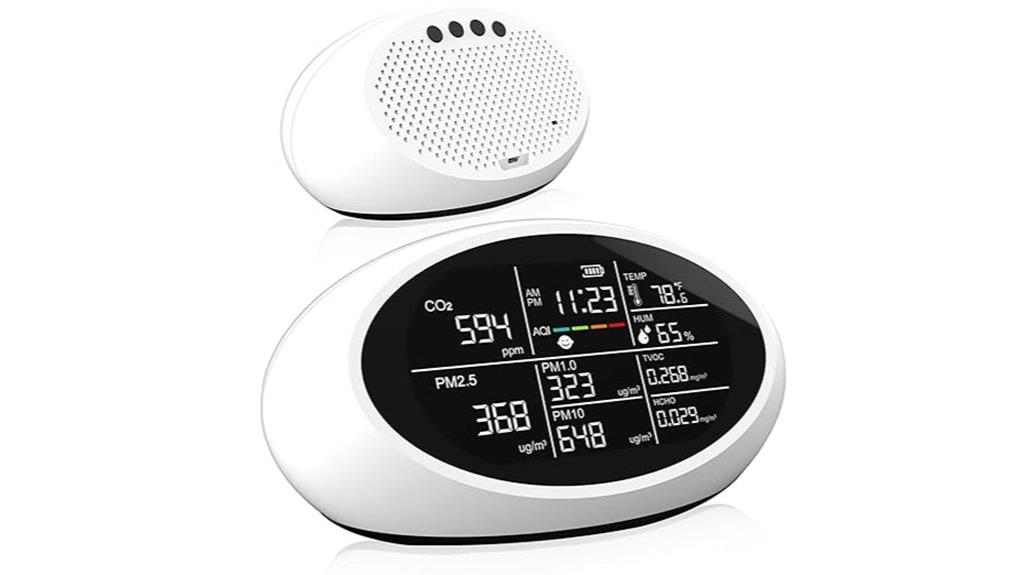
If you’re seeking a thorough indoor air quality solution, the 12-in-1 Indoor Air Quality Monitor stands out because it measures multiple parameters like CO2, TVOC, particulate matter, temperature, and humidity all in one device. It features a bright, easy-to-read screen, real-time updates, and a user-friendly setup. The smiley face indicator provides quick air quality assessments, and the CO2 alarm adds safety. It can run on battery or plugged in, offering flexible placement. While some users report inconsistent readings, especially for humidity, overall, it helps raise awareness of air conditions and prompts actionable changes. It’s a versatile, helpful device despite some reliability concerns.
Best For: individuals seeking a comprehensive indoor air quality monitor that provides real-time data on multiple parameters and enhances awareness for healthier living environments.
Pros:
- Measures 12 different air quality parameters, including CO2, TVOC, particulate matter, temperature, and humidity, all in one device
- Bright, easy-to-read screen with real-time updates and a user-friendly setup process
- Features a smiley face indicator for quick air quality assessment and a CO2 alarm for safety
Cons:
- Some users experience inconsistent readings, particularly for humidity, which may not respond well to humidifier use
- Battery life can be limited, requiring frequent recharging or continuous power supply, with reports of rapid drain
- Occasional quality control issues, such as malfunctioning units, poor connectivity, or misleading product representations
SAF Aranet4 Home Indoor Air Quality Monitor
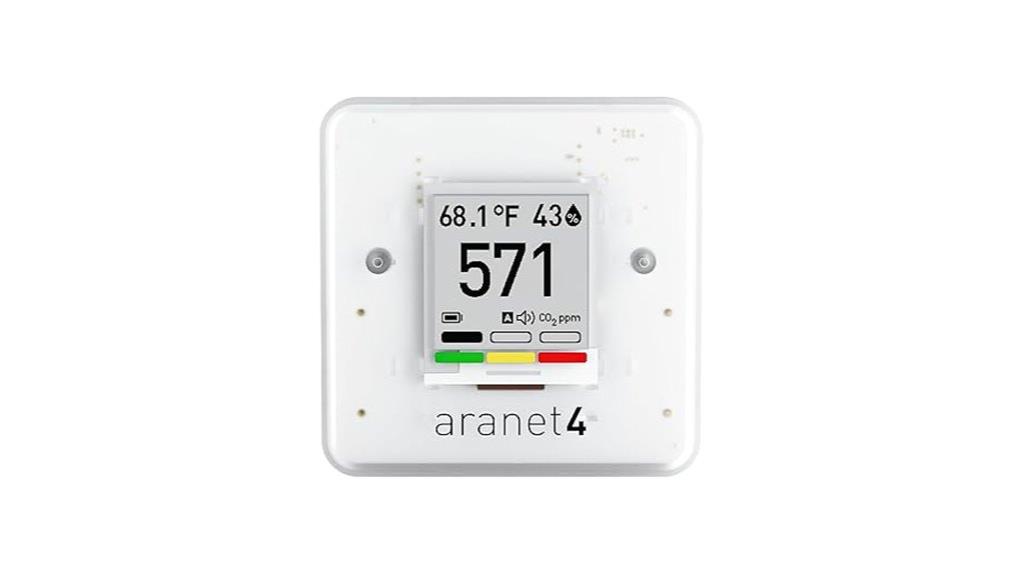
Are you seeking a portable, highly accurate air quality monitor for personal or professional use? The SAF Aranet4 Home is an excellent choice. It measures CO2, temperature, humidity, and atmospheric pressure in real-time, helping you optimize ventilation. Its sleek e-ink display is energy-efficient and easy to read, while Bluetooth connectivity allows quick data sync within 6-8 meters. Powered by two AA batteries, it can last up to four years. Though it lacks Wi-Fi, its NDIR sensors provide precise CO2 measurements within 15 ppm. Ideal for homes, offices, or travel, it’s a reliable device to monitor and improve your indoor air quality.
Best For: individuals or professionals seeking a portable, highly accurate CO2 and indoor air quality monitor for home, office, or travel use.
Pros:
- Highly accurate NDIR CO2 sensor with calibration recommended for best results
- Long battery life of up to 4 years with two AA batteries, reducing maintenance needs
- Compact, lightweight design with an energy-efficient e-ink display for easy readability
Cons:
- Lacks Wi-Fi or cloud connectivity, limiting remote monitoring capabilities
- Bluetooth range is slightly shorter compared to some competitors, restricting flexibility
- Does not measure other pollutants like VOCs, radon, or particulate matter for comprehensive air quality assessment
CO2 Monitor with Adjustable Alerts and Backlight
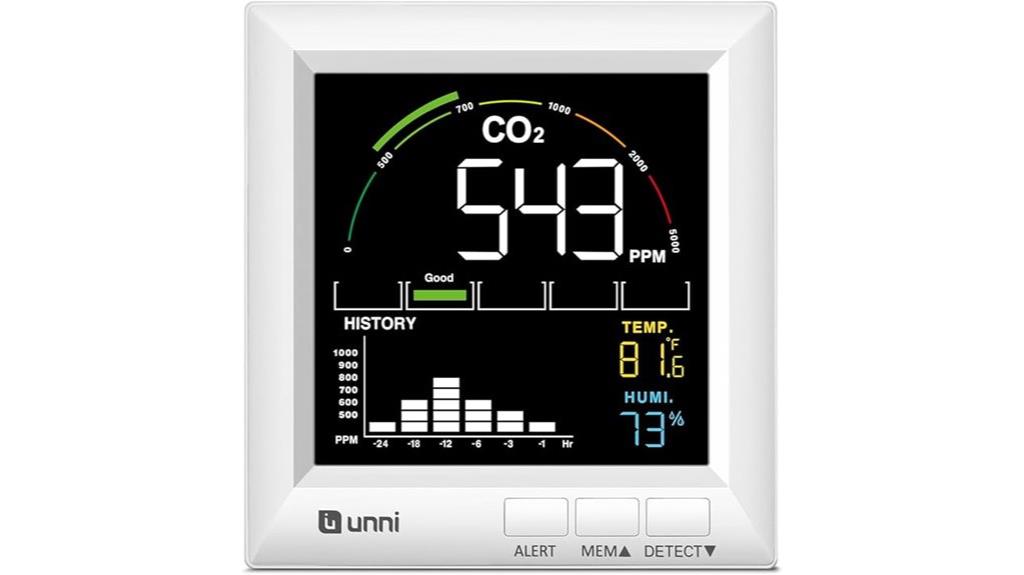
A CO2 monitor with adjustable alerts and backlight is ideal for anyone seeking customizable, real-time air quality management. I appreciate its Swiss-made photoacoustic sensor for precise readings, detecting CO2 levels from 400 to 5000 PPM with high accuracy. It displays temperature, humidity, and historical data, helping me track trends. The adjustable alert volume and backlight settings let me customize notifications and display brightness for day or night use. Its sleek, portable design fits on a tabletop or wall. With USB power and battery backup, it’s reliable during outages. Overall, it’s a user-friendly device that ensures healthier indoor air by providing actionable insights.
Best For: individuals seeking a customizable, accurate, and portable indoor air quality monitor to ensure a healthy living or working environment.
Pros:
- High-precision Swiss-made photoacoustic sensor provides reliable and accurate CO2, temperature, and humidity readings.
- Adjustable alert volume and backlight settings allow personalized notifications and display visibility for day or night use.
- Compact, portable design with USB power and battery backup ensures convenience and reliability during power outages.
Cons:
- Requires calibration in a standard 400 PPM environment, which may be inconvenient for some users.
- Batteries are not included, necessitating separate purchase for backup power.
- Placement sensitivity means it should be positioned away from direct breath or interference sources to prevent false readings.
Factors to Consider When Choosing Indoor Air‑Quality Sensors
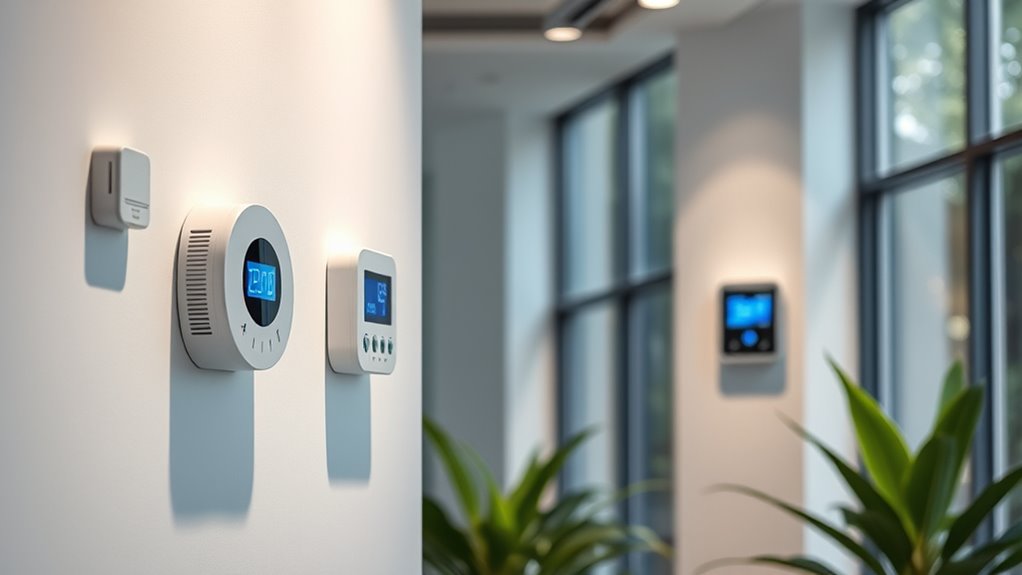
When choosing indoor air-quality sensors, I look at what monitoring capabilities are essential for my needs. It’s important to consider how accurate and easy to calibrate the sensors are, along with how simple they are to set up and use. Additionally, I weigh options like smart features, power sources, and portability to find the best fit.
Monitoring Capabilities Needed
Choosing the right indoor air-quality sensors depends on understanding their monitoring capabilities, including accuracy, detection range, and real-time data provision. I look for sensors that accurately measure specific pollutants like CO2, VOCs, or PM2.5, depending on my needs. Different sensors, such as NDIR for CO2 or electrochemical for gases, have varying detection ranges that impact how reliably they monitor pollutant levels. Multi-parameter sensors that combine measurements provide a fuller picture of air quality. I also prioritize sensors that deliver real-time data, trend analysis, and alert notifications, so I can respond quickly. Including environmental parameters like temperature and humidity enhances understanding of factors influencing air quality. Ultimately, evaluating these capabilities helps me choose sensors that effectively monitor and manage indoor air conditions.
Sensor Accuracy and Calibration
Have you ever wondered how reliable your indoor air-quality sensor truly is? Accuracy is vital for trustworthy readings, especially for parameters like CO2, VOCs, and particulate matter, where ±5% or better precision is ideal. Regular calibration, whether manual or automatic, helps maintain this accuracy by correcting drift caused by environmental factors or sensor aging. Sensors with built-in calibration features or factory calibration options typically provide more consistent data, reducing the need for frequent adjustments. Keep in mind that detection technology, such as NDIR for CO2 or electrochemical sensors for gases, impacts reliability. Environmental influences like humidity, temperature, and airflow can also affect sensor performance, making proper calibration and selection key to accurate indoor air quality monitoring.
Ease of Use and Setup
Selecting an indoor air-quality sensor that’s easy to set up and operate can make a significant difference in how effectively you monitor your environment. A user-friendly device should have clear, simple instructions and minimal setup steps, so anyone can get it running quickly. Devices with intuitive interfaces, like large displays or straightforward buttons, allow for quick, hassle-free operation without needing technical expertise. Wireless options such as Bluetooth or Wi-Fi simplify configuration and enable remote monitoring, reducing the need for complex wiring or professional help. Quick startup times and automatic calibration features help you begin monitoring promptly, without lengthy delays or manual adjustments. Clear indicators, like visual alarms or status lights, provide immediate feedback, making ongoing operation and maintenance straightforward and stress-free.
Smart Integration Features
Smart integration features are essential when evaluating indoor air-quality sensors because they enable seamless connectivity with your existing home automation systems. With these features, sensors can automatically adjust devices like air purifiers and thermostats based on real-time data, improving air quality effortlessly. Compatibility with voice assistants such as Alexa, Google Assistant, or Apple HomeKit offers added convenience through voice commands and routines. Many sensors support app-based monitoring, giving you remote access to data, alerts, and historical trends on your smartphone or tablet. Integration with smart home ecosystems allows sensors to trigger routines—like activating ventilation when pollutant levels spike. Devices with Wi-Fi or Bluetooth connectivity ensure smooth data sharing and control, helping you create a cohesive, automated indoor air quality management system that’s simple and effective.
Power and Portability
When choosing indoor air-quality sensors, considering their power options and portability is crucial for ensuring they meet your specific needs. Battery life varies widely—some devices last years on low-power modes, while others require daily charging or frequent battery replacements. Many portable sensors use rechargeable batteries, giving you flexibility to monitor different areas without constant power sources. Power options like USB charging, AAA batteries, or built-in rechargeable batteries influence how easily you can place and maintain the sensor. Devices with long-lasting batteries or multiple power choices are ideal for areas with limited outlets or outdoor use. Portability is further enhanced by lightweight, cordless designs, making it simple to move sensors between rooms or take them on the go. These factors help you find a sensor that fits your lifestyle and monitoring needs.
Frequently Asked Questions
How Often Should Indoor Air Quality Sensors Be Calibrated?
When it comes to calibrating indoor air quality sensors, I recommend checking the manufacturer’s guidelines first. Typically, I calibrate my sensors every 6 to 12 months to guarantee accuracy. Regular calibration is essential because sensors can drift over time, leading to false readings. If you’re using your sensors frequently or in a sensitive environment, more frequent calibration might be necessary. Consistent calibration keeps your air quality data reliable.
Can These Sensors Detect Allergens Like Pollen or Pet Dander?
Ever wonder if your air-quality sensor can detect allergens like pollen or pet dander? Most sensors focus on pollutants like VOCs, CO2, and particulate matter, but many don’t specifically target allergens. I’ve found that allergen detection usually requires specialized devices or filters. So, while your sensor helps monitor overall air quality, for allergens, you might need additional tools or air purifiers designed specifically for that purpose.
Are Indoor Air Quality Sensors Compatible With Smart Home Systems?
You’re wondering if indoor air quality sensors work with smart home systems. I can tell you they often do! Many sensors are compatible with popular platforms like Amazon Alexa, Google Home, or Apple HomeKit. This means you can automate air purifiers or ventilation based on sensor readings. Just make sure to check the specific model‘s compatibility before buying, so it integrates smoothly into your existing smart home setup.
What Is the Typical Lifespan of an Indoor Air Quality Sensor?
Ah, the timeless quest for the perfect air sensor that never dies—unfortunately, no such marvel exists. Typically, indoor air quality sensors last about 2 to 5 years before they start giving you false readings or just give up entirely. Regular calibration and maintenance can extend their life, but eventually, even the best sensors need replacing. Trust me, I’ve learned the hard way—nothing lasts forever, especially in the digital domain.
Do Sensors Provide Real-Time Air Quality Updates or Only Periodic Reports?
Most indoor air quality sensors provide real-time updates, allowing you to monitor air conditions continuously. They often have digital displays or connect to smartphone apps for instant alerts. While some older or simpler models might only offer periodic reports, newer sensors are designed for real-time tracking, helping you respond quickly to any pollutants or changes. I recommend choosing a sensor with real-time data for the best air quality management.
Conclusion
Choosing the right indoor air-quality sensor feels like finding a trusted compass in a sea of options. With so many advanced features, you’re empowered to breathe easier and create a healthier home environment. Remember, the perfect sensor isn’t just a gadget—it’s your silent guardian, ensuring every breath you take is pure and safe. After all, isn’t it worth investing in peace of mind for the air we live in?

